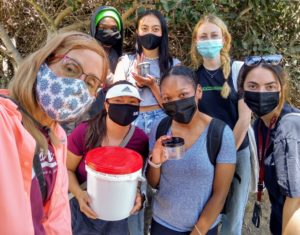By Martina Giselle Ramirez
Professor of Biology and Former Director of the Center for Teaching Excellence (June 1, 2021)
Pride Month 2021 marks the attainment of a number of personally significant anniversaries. Specifically, it will be:
- 11 years since I came out as trans at LMU and elsewhere (2010);
- 7 years since I had my legal name change, and first had the F gender marker appear on legal docs (2014);
- 5+ years since I started living on my own (2015);
- 4+ years since gender confirming surgery, part 1 (2016);
- 4 years since gender confirming surgery, part 2 (2017).
While those have all been key milestones along my path to living as a woman, there are of course the prior decades when I lived less authentically, including the first 11 years after I returned to LMU as a faculty member in 1999. Since there are many former students who got to know both the “old” and “new” me, it was quite evident to them that the new Martina was in a notably better space. Some of these alumni observations are included in “Happier as a Woman” (Cleis Press 2019, co-authored with Alicia Partnoy). As noted in the book, the dream of gender transition occurred to me in seventh or eighth grade, but given my circumstances and lack of finances, I never thought this would come true in my lifetime. Since so many in a similar situation have drifted into depression and suicidal ideation and action, more than a few people have asked how I managed to just keep going, decade after decade, until I was finally able to live my dream. My answer: The need to follow my Prime Directive, which is to support the success of marginalized students in STEM, no matter what. Or as I facetiously call it, the Spartacus Plan.

The Spartacus Plan was inspired by the movie “Spartacus,” Stanley Kubrick’s 1960 epic which won four Academy Awards. Spartacus was a slave who escaped from a gladiator training camp to lead an army of escaped slaves and gladiators numbering in the tens of thousands. His army defeated Roman forces many times until they were finally beaten as they marched against Rome. What struck me most about the film is that with the proper training (cinematically, gladiator camp), even those considered ‘marginal’ could become supremely skilled. Thus, the Spartacus Plan is simply my use of mentorship and the involvement of students in research efforts concerning spiders (aka, the Spider Lab) as catalysts for their professional development, since mentorship and student involvement in scholarly work with a faculty member boost student retention and performance.
This all-in approach to supporting students is a “comeback” to personal experiences with various –isms starting when I was young. First, about two years after I was adopted as a baby by Mexican American parents from Pomona, California, my dad was framed for embezzlement and was incarcerated, due to his ethnicity and entry into local political activism. In a historically segregated city with an all-Caucasian male city council, he was perceived as a threat and was “shut down” by the powers that be. My dad’s conviction led to the loss of his real estate and life insurance businesses, as well as the homes he and my mom owned, leading to years of financial hardship and no health coverage for any of us.
Later, during graduate school in the Biology Department at UC Santa Cruz, I endured a “chilly” atmosphere for those not matching the cis, heteronormative Caucasian male “ideal” in STEM, leading a number of women and students of color in my peer cohort to drop out along the way. Finally, during my years as a contingent faculty member at four institutions during the 1990’s, I experienced everything from memos being circulated behind my back to losing out on long-term employment opportunities, due to my ethnicity and living openly as transgender. Indeed, it was the experiences of those years which led me to “go into the closet” for my first 11 years as a faculty member at LMU.
The Spartacus Plan is also a response to my experiences as an LMU undergraduate (1977-1981). During those years, LMU had much less diversity in terms of gender and ethnicity among its faculty members than it does today. For example, during my first term at LMU in fall 1977, the professor for my freshmen calculus course was Jacqueline Dewar, one of the first women hired for a tenure-track position in the Frank R. Seaver College of Science and Engineering (CSE). Thereafter, I had only male professors for the balance of my CSE curriculum (courses in biology, chemistry, physics) at LMU. Given the absence of women faculty teaching the rest of my STEM courses at LMU, it occurred to me that if a student seldom, if ever, saw a faculty member who looked like them in their STEM courses and majors, she/he might not necessarily feel inspired to carry on, especially when in classes for other majors, they did see faculty members they could relate to in gender and/or ethnicity.
Indeed, while a number of peers in my biology major cohort did not persist in the major to graduation, as they either changed to non-STEM majors or transferred to other institutions, this was especially true for those who were women and/or from underrepresented backgrounds. This realization that role models mattered is a key reason I committed to a faculty career for myself, since I knew that being a professor would allow me to be a change agent in this area, someone who could boost the representation of women and underrepresented people in STEM, one person at a time. As noted in “Happier as a Woman,” I would not have considered my life a loss even if I did not transition, as long as I could leave behind a legacy of smart, strong and successful former students.
As for the vehicle for the Spartacus Plan – the Spider Lab – students come aboard in a variety of ways: Usually by my visiting office to make their pitch for why they should be part of the lab, but also by being a friend, roommate, and sometimes, the significant other of someone already in the lab. During our “interview conversations,” as long as the student at hand is willing to work hard and thinks the projects I conduct in spider conservation genetics, environmental toxicology, and reproductive biology are of interest to them, I usually welcome them to the team (and being scared of spiders is NOT a deal breaker, since working with them in lab usually dispels fear). Thereafter, members of the Spider Lab are always involved in all phases of our spider studies, from conception to publication. They also attend regular meetings to discuss scientific papers and to analyze each other’s research. This structure not only exposes students to current ideas in conservation/environmental/reproductive biology and to a range of developing projects, but also fosters a cohesive atmosphere among the “Spider Lab’ers.”
This full-engagement research experience has made them highly successful in gaining admission to graduate and professional schools, as well as in securing employment with a range of firms and agencies in STEM related fields. Since these students have always been largely female, with significant numbers from groups which are underrepresented in STEM (by ethnicity, but also by first-generation, rural, LGBTQ+, and undocumented status), their success has been especially gratifying. For example, from 2011-16, 69 students in the Spider Lab gave conference presentations. Of these, 65 were women and 39 were members of groups which are underrepresented in STEM fields. All 69 students have since gone on to graduate and professional programs and/or to employment in areas relevant to their STEM majors.

Over the decades, this has led to the Spider Lab being perceived as welcoming and friendly, where considerable camaraderie exists and “cool” work gets done. This is also a world where my interest in each member’s growth and realizing their dreams is a given. In “Happier as a Woman,” Catherine Leffler (née Coverley, 2008) described my attitude based on her years in the lab as “I’m going to accept you and make you part of this family, part of this community. And I’m not only going to accept you and treat you very well, but I’m going to take you to places in your career and academics that you couldn’t have gone to otherwise. And I have no qualms around that. You don’t owe me anything. I’m just going to give to you and accept you.”
Thus, while the research program I have developed at LMU has certainly led to a better understanding of spider biology, it has also contributed something of perhaps greater value to LMU and the wider world – human capital in the form of the Spider Lab alumni. Finally, carrying out the Spartacus Plan over the decades is what kept me in the game of life, allowing me to be on the scene when things finally fell into place to live authentically as a woman. So to the vast and colorful cast of Spider Lab’ers past and present, I say: Thank you for being my joie de vivre!
DEI Buzz
- Visit LMU’s Pride Month hub
- Cultural Consciousness Conversations is a year-long dialogue that aims to bring our community members closer together; we build bridges of understanding by sharing our stories, listening to others, and discussing important topics that shape our worldviews and cultural experiences. The cohort consists of faculty, staff, and administrators across various sectors of LMU, and all from diverse backgrounds. Sign up for the 2021-22 cohort. The program begins with an all-day retreat in September and continues with a meeting once a month until May. View this year’s cohort here. If you recognize any of your colleagues who have completed C3, ask them about the program.
- The Inclusive History and Images Project (IHIP), in cooperation with the university’s Anti-Racism Project, will gather oral histories and artifacts from alumni and public sources with the goal of knowing ourselves better, and gaining a deeper understanding of Loyola Marymount University. Recognizing that there have been periods of failure, of inattention, and ignorance that have not served our students well, IHIP is digging into the institution’s lived history to gauge a more full understanding of who we are in all our diversity, where we need to continue to grow to be more inclusive, and to chart a course for a better future. View the website and submit your own contribution here.
- Contribute to In Six Words for LGBTQ+ Pride – We will feature more six-word stories throughout the year, so use your words and join the conversation.
This week’s example is from Dr. Alicia Partnoy, Professor Emerita of Modern Languages and Literatures:
“A survivor. Listen to her voice.”

Dr. Alicia Partnoy retired from teaching this month after 23 years at LMU. She is an internationally acclaimed writer, and human rights activist. The author, translator and editor of 13 books, Partnoy was exiled to the United States after being imprisoned for her student activism in the 70’s by Argentina’s military dictatorship. Her most recent book is this collaboration with Martina G. Ramirez. Her first publication, “The Little School: Tales of Disappearance and Survival,” a series of short vignettes about her experience in one of the extermination camps where 30,000 Argentine citizens disappeared between 1976-83, was presented as evidence in the trials against the genocide perpetrators. She, too, is a survivor.




